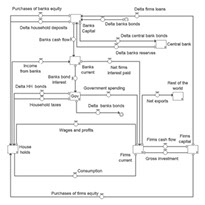
-02.png?crc=161747495)
f
Archive
Please note that this is an archive page. For current projects, please visit cusp.ac.uk or timjackson.org.uk

In order to make use of the model below, a current flash player is required. Please note that third party cookies must be fully enabled in Firefox (Preferences > Privacy > Accept third-party cookies > Always).
Alternatively, please try to access the model from here.
Does interest-bearing debt create a 'growth imperative'?
An early application of our FALSTAFF model addresses the question of whether a capitalist economy with interest-bearing money can ever sustain a ‘stationary’ (or non-growing) state, or whether, as often claimed, capitalism has an inherent ‘growth imperative’ which arises from the creation of money as interest-bearing debt. Our Working Paper describes a simplified version of FALSTAFF and uses this version of the model to explore the potential for stationary state outcomes in an economy with balanced trade, debt-based money, and private equity.
Contrary to claims in the literature, we find that neither credit creation nor the charging of interest on debt create a ‘growth imperative’ in and of themselves. We show further that it is possible to move from a growth path towards a stationary state without either crashing the economy or dismantling the system. Our model supports critiques of austerity and underlines the value of countercyclical spending by government. Nonetheless, there remain several good reasons to support the reform of the monetary system.
Interested readers can explore the implications for themselves in the online beta version of FALSTAFF below. Alternatively, please try to access the model from the ISEE website directly.

© Tim Jackson 2016. Website design & management: kultur.work
